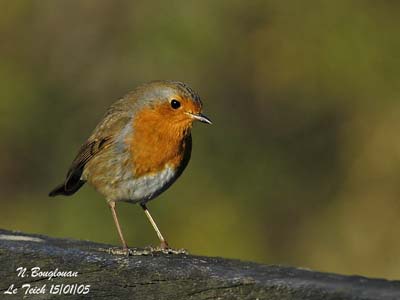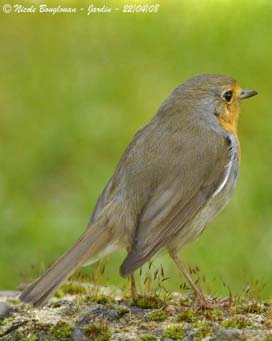
European Robin
Erithacus rubecula
Passeriforme Order – Muscicapidae Family
Very common and familiar species (as its name indicates it), the European Robin is really the king of the gardens. Rather solitary outside the breeding season, it is very close to us in winter, begging some bread crumbs at the kitchen’s door. It will consume also insects, worms, fruits, seeds, and will sing for us in at dawn as soon as the spring begins. Its melodious song charms us even if it awakes us!
According to the areas, it is sedentary or migratory. In spring, it builds its nest among the vegetation, well hidden in ivy, a hedge or the thick foliage of a shrub. It is a territorial bird which will defend its territory against other species, or even against other robins. These fights can even sometimes become violent.
BIOMETRICS:
Length: 14cm; Wingspan: 20-22 cm; Weight: 15-20 g
LONGEVITY: about 10 years
DESCRIPTION:
The European Robin is a territorial bird and its presence in the garden is source of interesting observations.
Male and female are similar. Crown, nape and upper parts, including wings and tail are soft brown. We can see a fine buffy wing bar, sometimes indistinct.
Face, throat and chest are bright red-orange, bordered with grey except on forehead. The underparts are rather whitish with pale reddish-brown flanks.
The fine bill is dark. Eyes are dark brown. The very fine legs are pinkish-brown.
The juvenile is brown overall, with the plumage mottled of paler brown. The underparts are paler and speckled with beige or pale brown. The red-orange spot is absent, and will appear only after the first moult, two months later approximately.

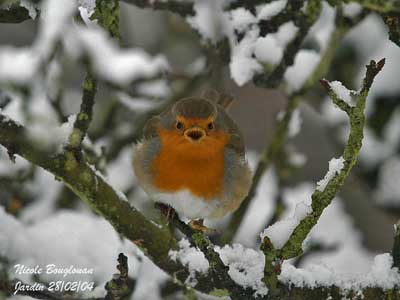
VOICE: SOUNDS BY XENO-CANTO
The European Robin’ typical call is a dry “tic”, repeated and uttered in short series, “tic-tic-tic…” as by juveniles as by adults. It also utters a short, tiny, shrill and a plaintive call “siiih” when it is anxious or alarmed.
The song is a series of chirp phrases, soft and clear sounds and of short trills stopping abruptly.
The European Robin sings mainly to attract the female and to establish the territory, rather in the early morning, perched on exposed pole. Sometimes, it sings at night if it is close to a street lamp. It sings all the year, except in late summer when it is moulting. In autumn, its songs are softer, even a little melancholic.
HABITAT :
The European Robin lives in forests, natural wooded areas, hedges, parks and gardens. We can also find it in various kinds of shrubby covers in more open areas. Usually, male is more sedentary than female which will perform some post-breeding dispersions.
RANGE:
The European Robin lives in Europe and United Kingdom. Birds living in the northern parts of the habitat migrate southwards in winter. We also find it in North Africa, to East of Siberia and Iran. It is also present on the islands of the Atlantic such as Madeira, Canary Islands and the Azores. Attempts to introduce the species on other continents failed.
BEHAVIOUR:
The European Robin is often perched in open when hunting. It watches carefully to the ground in order to detect a prey. It hops here and there while pecking among stones or grass.
Its typical attitude makes it easy to recognize. It flicks its tail up and down, with slightly arched wings lowered and the head in the shoulders.
If threatened, it moves wings and tail and scans carefully the neighbourhoods, before flying away under cover.
The European Robin may become very aggressive when it defends its territory. These disputes can degenerate into violent combats, more or less long, where the birds give pecks and scratches. Both males face to face inflate the chest in order to display the red-orange feathers. The goal is to pin down the adversary to the ground, which signs its defeat. Some fights sometimes end with the death of one of the combatants.
The European Robin is able to chase away a large bird from its territory. It can also attack its own reflection in a glass if it sees some red feathers. It inflates its plumage and lowers its wings, ready for the fight.
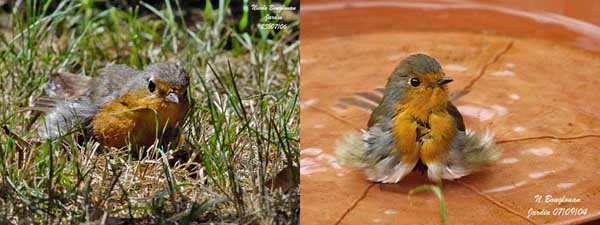
The pairs can be formed as soon as January. Male and female lives in the same territory until March, but any display is still observed. The territory is defended. The male sings strongly and comes close to the female which builds the nest. It regularly performs courtship feeding during this period. But she quickly chases it by pursuing. Indeed, the female robin is very unobtrusive when she builds the nest, and the presence of the singing male close to her would make locate the nest-site.
However, the European Robin remains a bird very appreciated of human because its melodious songs and its familiarity in the garden and close to habitations.
PERSONAL OBSERVATION:
I attended a combat between two robins in my garden three years ago, in 2005. There was a young male of the year, very familiar with us, which regularly came to perch on an armchair when we were on the terrace. It is in this way which I noticed that it had an awry toe at one leg. This sign always helped me to recognize it, as well as if it had been ringed!
The scene occurred in August, when this young bird moulted, displaying the red-orange spot of the chest. One evening, it came as usual on the terrace, and his father arrived like a tornado and attacked it, in order to chase it away from the parental territory. Normally, this kind of reprimand is enough to discourage the young which abandon the area to settle elsewhere.
It was to know little about this young rebel which resisted. The two birds clashed while fluttering in front of each other, at few centimetres above the ground, bills and claws ahead while giving shrills. At one time, we were very surprised by seeing the adult to abandon, knowing that this kind of fight could kill one of them. The adult laid down on the ground, on the back with the legs held towards its son to protect itself from the pecks. The young immediately stopped its attacks and let its father to go away, and we did not see it again anymore.
The young bird came close to us, and I recognized it thanks to its awry toe.
This year, in 2008, it is always the king of our garden where it breeds successfully. It is very familiar, especially in winter when it enters the kitchen or by any opened window, leaving each time a “trace” of its passage, in small discrete droppings but quite present nevertheless!
FLIGHT:
The European Robin flies short distances, performing wide undulations
In the air. Outside the migrating period, it does not fly too much.
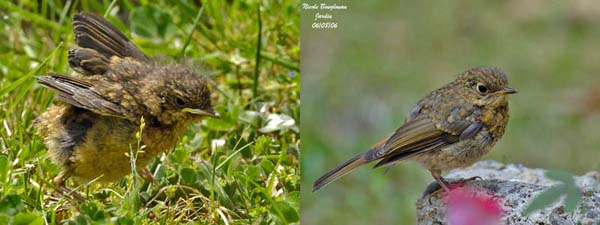
REPRODUCTION:
The European Robin builds its nest a few metres above the ground, well hidden among the vegetation. It also may nest in cavity or crevice in a stone wall, but also in strange places such as letter-box or any pot in baked earth!
Female starts the construction in late March. The cup base is made with dry leaves and moss. The interior is lined with dry grasses and rootlets, hair and feathers.
She usually lays 5 whitish eggs with dusky markings. Incubation lasts about 13 days, by female alone. During this period, she regularly leaves the nest for feeding. She is fed by the male.
She broods the chicks at hatching and during the first week, while the male often brings food at nest. From the second week, the chicks are frequently fed by both parents. They abandon the nest about two weeks after hatching, and adults feed them for 15 days more.
The female may start a second clutch, sometimes in the same nest, but often in a new nest.
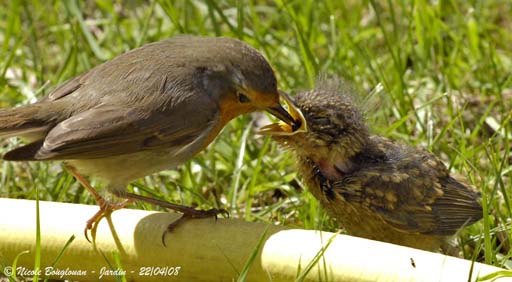
DIET:
The European Robin feeds mainly on insects and spiders, but also on fruits, berries and seeds during cold winters. It also consumes earth worms.
PROTECTION / THREATS / STATUS:
Populations of European Robins are not threatened and numbers increased of about 20% since the last 25 years.
However, this species has some predators such as domestic cats, and sometimes the young raptors which learn to hunt before to attack larger birds.
Ang : European Robin
All : Rotkehlchen
Esp : Petirrojo Europeo
Ital : Pettirosso europeo
Nd: Roodborst
Russe: Зарянка
Sd: Rödhake
Text and pictures by Nicole Bouglouan
More pictures: PHOTOGRAPHIC RAMBLE
Sources:
THE HANDBOOK OF BIRD IDENTIFICATION FOR EUROPE AND THE WESTERN PALEARCTIQUE by Mark Beaman, Steve Madge - C.Helm -ISBN: 0713639601
THE COMPLETE BOOK OF BRITISH BIRDS – Préface de Magnus Magnusson – Editeurs: Michael Cady- Rob Hume - ISBN: 0749509112
Wikipedia (Wikipedia, The Free Encyclopaedia)
